The 2020 Mac Mini Unleashed: Putting Apple Silicon M1 To The Test
by Andrei Frumusanu on November 17, 2020 9:00 AM ESTSection by Ryan Smith
M1 GPU Performance: Integrated King, Discrete Rival
While the bulk of the focus from the switch to Apple’s chips is on the CPU cores, and for good reason – changing the underlying CPU architecture if your computers is no trivial matter – the GPU aspects of the M1 are not to be ignored. Like their CPU cores, Apple has been developing their own GPU technology for a number of years now, and with the shift to Apple Silicon, those GPU designs are coming to the Mac for the very first time. And from a performance standpoint, it’s arguably an even bigger deal than Apple’s CPU.
Apple, of course, has long held a reputation for demanding better GPU performance than the average PC OEM. Whereas many of Intel’s partners were happy to ship systems with Intel UHD graphics and other baseline solutions even in some of their 15-inch laptops, Apple opted to ship a discrete GPU in their 15-inch MacBook Pro. And when they couldn’t fit a dGPU in the 13-inch model, they instead used Intel’s premium Iris GPU configurations with larger GPUs and an on-chip eDRAM cache, becoming one of the only regular customers for those more powerful chips.
So it’s been clear for some time now that Apple has long-wanted better GPU performance than what Intel offers by default. By switching to their own silicon, Apple finally gets to put their money where their mouth is, so to speak, by building a laptop SoC with all the GPU performance they’ve ever wanted.
Meanwhile, unlike the CPU side of this transition to Apple Silicon, the higher-level nature of graphics programming means that Apple isn’t nearly as reliant on devs to immediately prepare universal applications to take advantage of Apple’s GPU. To be sure, native CPU code is still going to produce better results since a workload that’s purely GPU-limited is almost unheard of, but the fact that existing Metal (and even OpenGL) code can be run on top of Apple’s GPU today means that it immediately benefits all games and other GPU-bound workloads.
As for the M1 SoC’s GPU, unsurprisingly it looks a lot like the GPU from the A14. Apple will have needed to tweak their design a bit to account for Mac sensibilities (e.g. various GPU texture and surface formats), but by and large the difference is abstracted away at the API level. Overall, with M1 being A14-but-bigger, Apple has scaled up their 4 core GPU design from that SoC to 8 cores for the M1. Unfortunately we have even less insight into GPU clockspeeds than we do CPU clockspeeds, so it’s not clear if Apple has increased those at all; but I would be a bit surprised if the GPU clocks haven’t at least gone up a small amount. Overall, A14’s 4 core GPU design was already quite potent by smartphone standards, so an 8 core design is even more so. M1’s integrated GPU isn’t just designed to outpace AMD and Intel’s integrated GPUs, but it’s designed to chase after discrete GPUs as well.
| A Educated Guess At Apple GPU Specifications | |||
| M1 | |||
| ALUs | 1024 (128 EUs/8 Cores) |
||
| Texture Units | 64 | ||
| ROPs | 32 | ||
| Peak Clock | 1278MHz | ||
| Throughput (FP32) | 2.6 TFLOPS | ||
| Memory Clock | LPDDR4X-4266 | ||
| Memory Bus Width | 128-bit (IMC) |
||
Finally, it should be noted that Apple is shipping two different GPU configurations for the M1. The Mac Mini and MacBook Pro get chips with all 8 GPU cores enabled. Meanwhile for the Macbook Air, it depends on the SKU: the entry-level model gets a 7-core configuration, while the higher-tier model gets 8 cores. This means the entry-level Air gets the weakest GPU on paper – trailing a full M1 by around 12% – but it will be interesting to see how the shut-off core influences thermal throttling on that passively-cooled laptop.
Kicking off our look at GPU performance, let’s start with GFXBench 5.0. This is one of our regular benchmarks for laptop reviews as well, so it gives us a good opportunity to compare the M1-based Mac Mini to a variety of other CPU/GPU combinations inside and outside the Mac ecosystem. Overall this isn’t an entirely fair test since the Mac Mini is a small desktop rather than a laptop, but as M1 is a laptop-focused chip, this at least gives us an idea of how M1 performs when it gets to put its best foot forward.
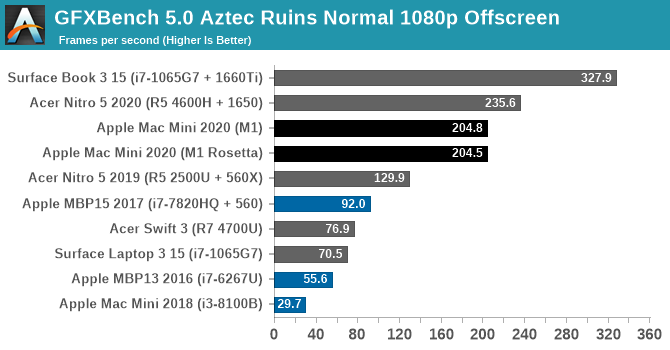
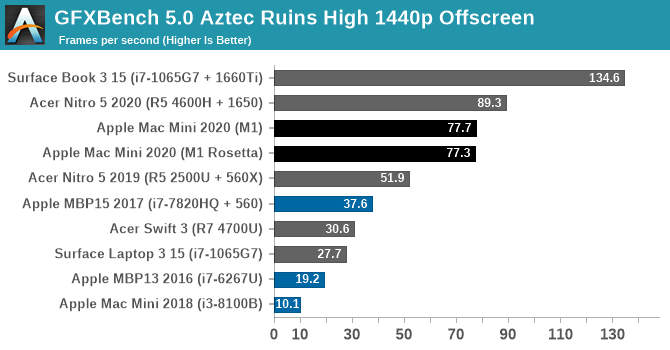
Overall, the M1’s GPU starts off very strong here. At both Normal and High settings it’s well ahead of any other integrated GPU, and even a discrete Radeon RX 560X. Only once we get to NVIDIA’s GTX 1650 and better does the M1 finally run out of gas.
The difference compared to the 2018 Intel Mac Mini is especially night-and-day. The Intel UHD graphics (Gen 9.5) GPU in that system is vastly outclassed to the point of near-absurdity, delivering a performance gain over 6x. And even other configurations such as the 13-inch MBP with Iris graphics, or a PC with a Ryzen 4700U (Vega 7 graphics) are all handily surpassed. In short, the M1 in the new Mac Mini is delivering discrete GPU-levels of performance.
As an aside, I also took the liberty of running the x86 version of the benchmark through Rosetta, in order to take a look at the performance penalty. In GFXBench Aztec Ruins, at least, there is none. GPU performance is all but identical with both the native binary and with binary translation.
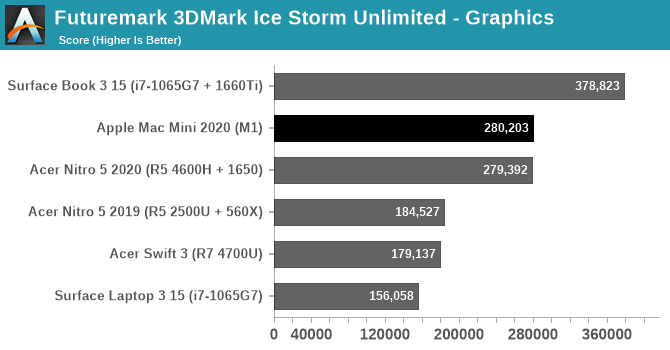
Taking one last quick look at the wider field with an utterly silly synthetic benchmark, we have 3DMark Ice Storm Unlimited. Thanks to the ability for Apple Silicon Macs to run iPhone/iPad applications, we’re able to run this benchmark on a Mac for the first time by running the iOS version. This is a very old benchmark, built for the OpenGL ES 2.0 era, but it’s interesting that it fares even better than GFXBench. The Mac Mini performs just well enough to slide past a GTX 1650 equipped laptop here, and while this won’t be a regular occurrence, it goes to show just how potent M1 can be.
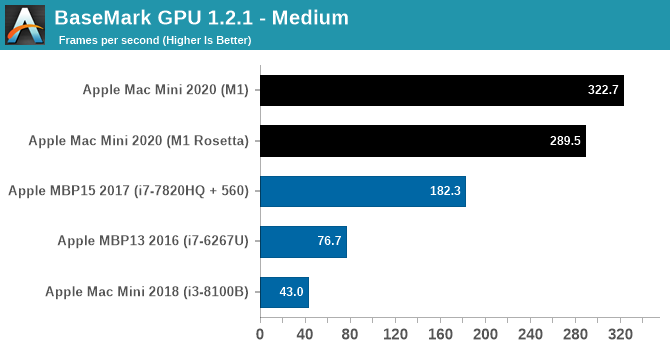

Another GPU benchmark that’s been updated for the launch of Apple’s new Macs is BaseMark GPU. This isn’t a regular benchmark for us, so we don’t have scores for other, non-Mac laptops on hand, but it gives us another look at how M1 compares to other Mac GPU offerings. The 2020 Mac Mini still leaves the 2018 Intel-based Mac Mini in the dust, and for that matter it’s at least 50% faster than the 2017 MacBook Pro with a Radeon Pro 560 as well. Newer MacBook Pros will do better, of course, but keep in mind that this is an integrated GPU with the entire chip drawing less power than just a MacBook Pro’s CPU, never mind the discrete GPU.
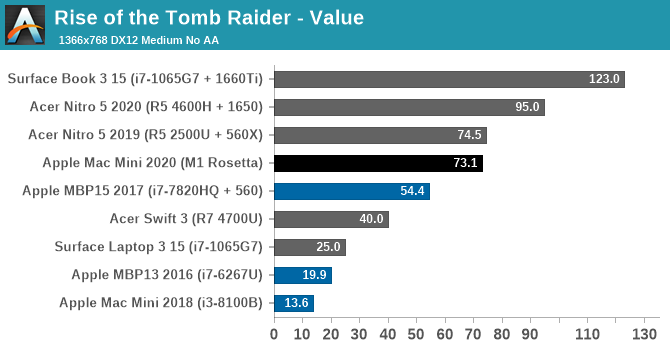
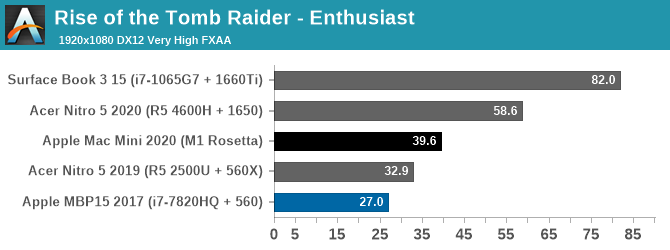
Finally, putting theory to practice, we have Rise of the Tomb Raider. Released in 2016, this game has a proper Mac port and a built-in benchmark, allowing us to look at the M1 in a gaming scenario and compare it to some other Windows laptops. This game is admittedly slightly older, but its performance requirements are a good match for the kind of performance the M1 is designed to offer. Finally, it should be noted that this is an x86 game – it hasn’t been ported over to Arm – so the CPU side of the game is running through Rosetta.
At our 768p Value settings, the Mac Mini is delivering well over 60fps here. Once again it’s vastly ahead of the 2018 Intel-based Mac Mini, as well as every other integrated GPU in this stack. Even the 15-inch MBP and its Radeon Pro 560 are still trailing the Mac Mini by over 25%, and it takes a Ryzen laptop with a Radeon 560X to finally pull even with the Mac Mini.
Meanwhile cranking things up to 1080p with Enthusiast settings finds that the M1-based Mac Mini is still delivering just shy of 40fps, and it’s now over 20% ahead of the aforementioned Ryzen + 560X system. This does leave the Mini well behind the GTX 1650 here – with Rosetta and general API inefficiencies likely playing a part – but it goes to show what it takes to beat Apple’s integrated GPU. At 39.6fps, the Mac Mini is quite playable at 1080p with good image quality settings, and it would be fairly easy to knock down either the resolution or image quality a bit to get that back above 60fps. All on an integrated GPU.
Update 11-17, 7pm: Since the publication of this article, we've been able to get access to the necessary tools to measure the power consumption of Apple's SoC at the package and core level. So I've gone back and captured power data for GFXBench Aztec Ruins at High, and Rise of the Tomb Raider at Enthusiast settings.
| Power Consumption - Mac Mini 2020 (M1) | ||||
| Rise of the Tomb Raider (Enthusiast) | GFXBench Aztec (High) |
|||
| Package Power | 16.5 Watts | 11.5 Watts | ||
| GPU Power | 7 Watts | 10 Watts | ||
| CPU Power | 7.5 Watts | 0.16 Watts | ||
| DRAM Power | 1.5 Watts | 0.75 Watts | ||
The two workloads are significantly different in what they're doing under the hood. Aztec is a synthetic test that's run offscreen in order to be as pure of a GPU test as possible. As a result it records the highest GPU power consumption – 10 Watts – but it also barely scratches the CPU cores virtually untouched (and for that matter other elements like the display controlller). Meanwhile Rise of the Tomb Raider is a workload from an actual game, and we can see that it's giving the entire SoC a workout. GPU power consumption hovers around 7 Watts, and while CPU power consumption is much more variable, it too tops out just a bit higher.
But regardless of the benchmark used, the end result is the same: the M1 SoC is delivering all of this performance at ultrabook-levels of power consumption. Delivering low-end discrete GPU performance in 10 Watts (or less) is a significant part of why M1 is so potent: it means Apple is able to give their small devices far more GPU horsepower than they (or PC OEMs) otherwise could.
Ultimately, these benchmarks are very solid proof that the M1’s integrated GPU is going to live up to Apple’s reputation for high-performing GPUs. The first Apple-built GPU for a Mac is significantly faster than any integrated GPU we’ve been able to get our hands on, and will no doubt set a new high bar for GPU performance in a laptop. Based on Apple’s own die shots, it’s clear that they spent a sizable portion of the M1’s die on the GPU and associated hardware, and the payoff is a GPU that can rival even low-end discrete GPUs. Given that the M1 is merely the baseline of things to come – Apple will need even more powerful GPUs for high-end laptops and their remaining desktops – it’s going to be very interesting to see what Apple and its developer ecosystem can do when the baseline GPU performance for even the cheapest Mac is this high.


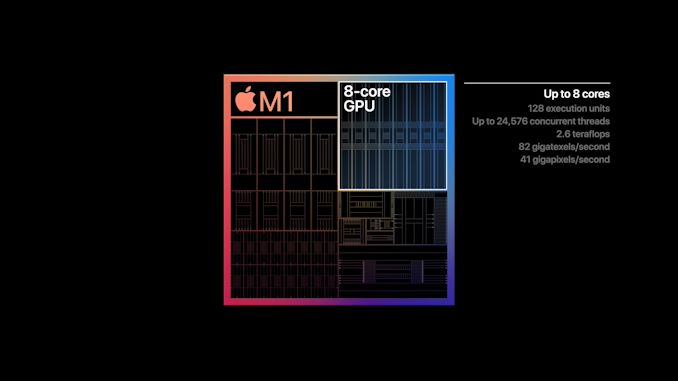








682 Comments
View All Comments
Spunjji - Tuesday, November 17, 2020 - link
Apples to Apples is comparing what's on offer to what's on offer. If AMD were on the verge of releasing Zen 4 I'd say hey, let's see what's in store, but you have to admit that right now Apple have leveraged 5nm to build a fundamentally solid design that has some significant competitive advantages.I suspect M1 will lose to AMD's offerings at the ~25W mark once Cezanne hits, which means good things for Zen 4 when it does indeed arrive, but this is a mighty good CPU as it stands at this time in 2020.
lilmoe - Tuesday, November 17, 2020 - link
Beating Intel doesn't say much. Intel is a well known issue in the tech industry. Apple isn't the only one complaining. Mobile Ryzen goes neck-to-neck with Intel desktop. This is well know fact. Apple doesn't have any breakthrough here; AMD did earlier this year. TSMC has great 7nm and a breakthrough 5nm process (Your move, Sammy).The M1 is Apple's A-Game in single thread. You won't see double digit improvements YoY.
Apples to apples (pro review):
- Consistent Charts.
- M1+Rosetta2 VS Zen2(4800U): THAT's what's available today.
- M1 Native vs Zen3 (Prediction/Analysis for Zen4): THAT is what M1/M2 Native will go up against.
- M1 Chrome/Javascript VS 4800U Chrome, NOT Safari+M1(Native) VS Chrome/Edge+4800U. That's a browser benchmark, not a CPU benchmark. Chrome all the way, then an educated prediction into how much Native would improve that.
- Actual popular games.
I'm dismissing this entire review. Any monkey can install and run a couple of benchmark apps.
andreltrn - Tuesday, November 17, 2020 - link
Why Chrome? What you people don't get is that people buying a Mac mini or a macbook air are buying a device. Like you would buy a refrigerator, a Nest thermostat. They will use what is the best for that DEVICE. They don't care about the processor. Even a processor (CPU) comparaison is bulls... when comparing the M1 with the AMD laptop offering. The M1 is a SOC with way more built-in functionality such as ML processor and accelerator and much more. A (intel or AMD) laptop CPU couldn't do what the M1 does in a properly coded app. EG. Final cut Pro or Logic or Safari for that mather. A device is the sum of it's parts. Not only a CPU specially in a laptop.vlad42 - Tuesday, November 17, 2020 - link
Why Chrome? Well because it is available for both operating systems. Of course another browser such as FireFox could also be used.We have seen time and time again that the web browser used can have an enormous impact on the results of browser based benchmarks. As you can see here in Anandtech's browser comparison on 9/10/2020, https://www.anandtech.com/show/16078/the-2020-brow... the Chromium version of Edge out performs FireFox in Speedometer 2.0 by roughly 35%! Since this article is not trying to compare the performance of different web browsers, the browser used should be kept the same.
In addition, since Speedometer 2.0 was made by Apple, it is highly likely that they likely put more weight on Safari updates improving the Speedometer score than, say, Google does with Chrome.
helpmeoutnow - Thursday, November 26, 2020 - link
@andreltrn lol keep it real. we are talking benchmarks. you can only compere software that runs on both systems.Spunjji - Tuesday, November 17, 2020 - link
Also, Zen 3 is in some of those comparisons... It wins as you'd expect, but dropping to 5nm wouldn't magically bring it to M1 power levels.vlad42 - Tuesday, November 17, 2020 - link
5nm would help by reducing the voltage, and thus power draw, for the chip. The bigger thing to remember is that there are no mobile versions of Zen 3 yet. Consider that the 5950X is only ~37% faster than the 4800U in single threaded Cinebench despite have a tdp 7 times higher. If the 5800U ends up having the same clocks as the 4800U, then the M1 would roughly have a 7% perf/W advantage. Granted, this assumes the 5800U’s score would be 19% faster than the 4800U's 1199.So, given the expected benefits that TSMC, Samsung, etc. have touted about 5nm, a die shrink from 7nm to 5nm would easily make up for this difference in power efficiency.
R3lay - Wednesday, November 18, 2020 - link
You can't compare single core performance and then compare then to the TDP. At single core the 5950X doesn't use 7x more power.Kangal - Saturday, November 21, 2020 - link
To be honest, a lot of comparisons of the Apple Silicon M1 are vague, misrepresentative or blatantly off. The best representative benchmarks I've seen are:Single Core, Geekbench v5, 5min run, Rosetta2
2020 Macbook Air (10W M1): ~1300 score
2019 MacBook Pro 16in (35W i9-9880H): ~1100 points
AMD Zen2+ Laptop (35W r9-4900HS): ~920 points
2019 Macbook Pro 13in (15W i5-8257U): ~900 points
AMD Zen2+ Laptop (20W r7-4800U): ~750 points
Multi-Thread, CineBench r23, 10min run, Rosetta2
AMD Zen2+ Laptop (35W r9-4900HS): ~11,000 score
AMD Zen2+ Laptop (20W r7-4800U): ~9,200 score
2019 MacBook Pro 16in (35W i9-9880H): ~9,100 score
2020 Macbook Air (10W M1): ~7,100 score
2019 Macbook Pro 13in (15W i5-8257U): ~5,100 score
Rendering Performance, Final Cut ProX, 10min clip
AMD Zen2+ Laptop (35W r9-4900HS): error on ryzentosh
AMD Zen2+ Laptop (20W r7-4800U): error on ryzentosh
2019 MacBook Pro 16in (35W i9-9880H): ~360 seconds
2020 Macbook Air (10W M1): ~410 seconds
2019 Macbook Pro 13in (15W i5-8257U): ~1100 seconds
GPU Performance, GFXBench v5 Aztec Ruins High, Rosetta2
2019 MacBook Pro 16in (i9 5600M): ~79 fps
2020 Macbook Air (M1 8CU): ~76 fps
AMD Zen2+ Laptop (r9 Vega-8): ~39 fps
AMD Zen2+ Laptop (r7 Vega-7): ~36 fps
2019 Macbook Pro 13in (i5 Iris Pro): ~20 fps
Gaming Perfomance, Rise of the Tomb Raider, 1080p High
2019 MacBook Pro 16in (i9 5600M): ~70 fps
2020 Macbook Air (M1 8CU): ~40 fps
AMD Zen2+ Laptop (r9 Vega-8): ~23 fps
AMD Zen2+ Laptop (r7 Vega-7): ~21 fps
2019 Macbook Pro 13in (i5 Iris Pro): ~12 fps
....so I share the well-grounded outlook that Dave Lee (D2D) has on the matter, where Linus (LTT) was more pessimistic than Dave but I think his opinions are pretty neutral overall. I simply out-right reject the unprofessional and unrealistic look that Andrei (Anandtech) has displayed in the previous article. Nor am I fully on-board with the overly-optimistic perspective that Jonathan Morrison demonstrated.
Kangal - Saturday, November 21, 2020 - link
More thoughts on the matter...I get there's the argument to be made that: new modern and more efficient apps are coming natively, that single-core is most important, low TDP is very important, and race to idle (or at least race to small cores) is important. From that perspective, the M1 in the Macbook Air is the best by a HUGE margin. We're talking a x3 better overall experience than the best x86 devices in such comparisons.
Then there's the alternate debate. That what you get is, what you get. So that legacy program performance is most important, single-core is no longer be-all-end-all, multi-thread being relevant for actual "Pro" users, and just as important as TDP is the Sustained Performance. When looking from that perspective, the Apple M1 in a MacBook Pro 16/13 is only equivalent to the very best x86 device performances. So basically a meh situation, not a paradigm shift.
So what can we realistically postulate from this, and expect from Apple and the industry?
Firstly, Apple disappointed us with the M1. In short, Apple played it safe and didn't really do their best. That means they purposely left performance on the table, it was artificial and it was deliberate. The why is simple, just so that they can incrementally introduce these increases, that way they can incentivise customers. In long, what they have now, the 4/8 setup is somewhat reminiscent to the current high-end phablets, or the 4c/8t hyperthreading setup of Intel CPUs, or the older AMD Bulldozer setup. At these thicknesses, there's really no need for the medium-cores, they should have killed it, and stuck with an 8-large-core design instead. These large ARM cores aren't too different to x86 core in size, so they could have afforded that silicon cost. As for operation, simply undervolt/underclock (1.5GHz) the whole stack, and ramp up 1-2 cores to high clocks/volts (3.5GHz) dynamically when necessary. That makes thread allocation simple, and here simple means more efficient software. And this means we can see a performance difference moving from an 11inch passive-cooled device, to a 17in active-cooled device. For example, 8-cores running at 4.0GHz, versus 2-cores running at 3.5GHz. And let's not forget the GPU which is fine as an 8CU (~GTX 1050) on an "ultraportable" like an 11in Macbook Air. But we we're expecting something more like 16CU (~GTX 1660) for the "regular laptop" 13in MacBook, and even beefier 32CU (~RTX 2070) for a "large laptop" 17in MacBook Pro. On top of this, the new SoC demands a smaller size internally, so we should have seen a much more compact Mac devices, and Apple didn't take advantage of this.
Other places Apple dropped the ball, is that they have less PCIe ports allocated. There is no dedicated GPU or eGPU option available. Their current iGPU is about on-par with GTX 1050, so impressive against AMD's and Intel's iGPUs... but it's still behind modern (low-profile) dedicated-GPUs from Nvidia's Volta or AMD's RDNA2. There's no support for 32bit x86 programs. And lastly, there is no bootloader support, so that people can run another OS such as Android, Linux distro, Windows10 ARM/Mobile (or perhaps even to boot x86-OS via a low-level translator).
And here's what Apple got right.
They released the Mac Mini Zero/Development device a year early to get developers primed. Their new Operating System, which is definitely NOT the same OS X (macOS), but is an "iOS-Pro OS" actually is stable. Their forwards-compatibility with iOS Apps runs without issues. Their backwards-compatibility for 64bit-macOS Apps actually runs very very very well (some code, such as the gpu-APIs are actually processed natively). And we can only surmise that most current Apps will run (average 60%) almost as good as running natively (min 49%-to-94% max), something Microsoft dropped the ball on with Windows 8/RT and have dragged their feet since. Whilst in the near future (3-4 years), they will remove the actual hardware-coprocessors that handle this x86-to-ARM translation, and they will use that "silicon budget" to add to the SoC, slightly improving native further. So with updating Applications, improving microarchitecture, improving lithography, increasing silicon budget, and thus extending it from an efficient design (4B+4s) to a (8 Big) performance design...... we will see performance literally x2-x4 in the coming 2-4 year timeframe (think Apple M2, M3, M4 in 2024). And I didn't even mention GPU improvements either. That's just too much pressure on the whole industry (Lenovo, HP, Dell, ASUS), and more specifically on Microsoft, AMD Zen, and Intel (lol) when it comes to their roadmap.
Plus, the current setup of 4-big, and 4-medium cores, is adequate, but works wonders for low-impact tasks and thermally limited devices. And they have demonstrated that their software is mature in handling these hybrid systems. So the current setup means the Macbook Air (ultra thin/light) has a phenomenal leap, and future iterations will benefit from this setup too. Also that means lower R&D time/effort/cost is necessary as most of the work between the smallest iPhone Mini, the medium-sized iPad-Mini, and the much larger Macs are closely related, as far as SoC is concerned. And it's a brilliant move to keep the current x86 line, and launch identical hardware with the M1 silicon. So all feedback will provide insight for future Silicon-M designs.
I personally think, they're going to move to having a better quality keyboard (bye crappy Butterfly) as now there is more internal space to play around with. And they will add new features to the Macs that are already included in iPhones, like barometer, GPS, etc etc. Also, they will add Apple Pen support (but no silo), with probably a magnetic holder. Lastly, I think they're going to evolve the design of the Macbooks... they will all have OLED HDR10+ displays, maybe in the 4K-5K resolutions, have a proper touchscreen, and mimic the Lenovo Yoga style with a 360' hinge.